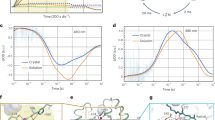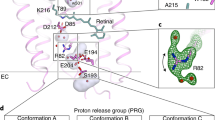Abstract
The basis of the chemiosmotic theory is that energy from light or respiration is used to generate a trans-membrane proton gradient1. This is largely achieved by membrane-spanning enzymes known as ‘proton pumps’2,3,4,5. There is intense interest in experiments which reveal, at the molecular level, how protons are drawn through proteins6,7,8,9,10,11,12,13.Here we report the mechanism, at atomic resolution, for a single long-range electron-coupled proton transfer. In Azotobacter vinelandii ferredoxin I, reduction of a buried iron–sulphur cluster draws in a solvent proton, whereas re-oxidation is ‘gated’ by proton release to the solvent. Studies of this ‘proton-transferring module’ by fast-scan protein film voltammetry, high-resolution crystallography, site-directed mutagenesis and molecular dynamics, reveal that proton transfer is exquisitely sensitive to the position and pK of a single amino acid. The proton is delivered through the protein matrix by rapid penetrative excursions of the side-chain carboxylate of a surface residue (Asp 15), whose pK shifts in response to the electrostatic charge on the iron–sulphur cluster. Our analysis defines the structural, dynamic and energetic requirements for proton courier groups in redox-driven proton-pumping enzymes.
This is a preview of subscription content, access via your institution
Access options
Subscribe to this journal
Receive 51 print issues and online access
$199.00 per year
only $3.90 per issue
Buy this article
- Purchase on Springer Link
- Instant access to full article PDF
Prices may be subject to local taxes which are calculated during checkout



Similar content being viewed by others
References
Nicholls, D. G. & Ferguson, S. J. Bioenergetics 2 (Academic, San Diego, 1992).
Wikström, M. Proton translocation by bacteriorhodopsin and heme-copper oxidases. Curr. Opin. Struct. Biol. 8, 480–488 (1998).
Gennis, R. B. How does cytochrome oxidase pump protons? Proc. Natl Acad. Sci. USA 95, 12747–12749 ( 1998).
Malmström, B. G. Cytochrome oxidase: pathways for electron tunneling and proton transfer. J. Biol. Inorg. Chem. 3, 339–343 (1998).
Michel, H. The mechanism of proton pumping by cytochrome c oxidase. Proc. Natl Acad. Sci. USA 95, 12819– 12824 (1998).
Rammelsberg, R., Huhn, G., Lübben, M. & Gerwert, K. Bacteriorhodopsin's intramolecular proton-release pathway consists of a hydrogen-bonded network. Biochemistry 37, 5001– 5009 (1998).
Luecke, H., Schobert, B., Richter, H.-T., Cartailler, J. P. & Lanyi, J. Structural changes in bacteriorhodopsin during ion transport at 2 Å resolution. Science 286, 255–260 (1999).
Nabedryk, E., Breton, J., Okamura, M. Y. & Paddock, M. L. Proton uptake by carboxylic acid groups upon photoreduction of the secondary quinone (QB) in bacterial reaction centres from Rhodobacter sphaeroides: FTIR studies on the effects of replacing Glu H173. Biochemistry 37, 14457–14462 ( 1998).
Yoshikawa, S. et al. Redox-coupled crystal structural changes in bovine heart cytochrome c oxidase. Science 280, 1723– 1729 (1998).
Konstantinov, A. A., Siletsky, S., Mitchell, D., Kaulen, A. & Gennis, R. B. The roles of two proton input channels in cytochrome c oxidase from Rhodobacter sphaeroides probed by the effects of site-directed mutations on time-resolved electrogenic intraprotein proton transfer. Proc. Natl Acad. Sci. USA 94, 9085–9090 (1997).
Lübben, M., Prutsch, A., Mamat, B. & Gerwert, K. Electron transfer induces side-chain conformational changes of glutamate-286 from cytochrome bo3. Biochemistry 38, 2048– 2056 (1999).
Junemann, S., Meunier, B., Fisher, N. & Rich, P. R. Effects of mutation of the conserved glutamic acid-286 in subunit I of cytochrome c oxidase from Rhodobacter sphaeroides. Biochemistry 38 , 5248–5255 (1999).
Hirst, J. et al. Kinetics and mechanism of redox-coupled, long-range proton transfer in an iron-sulfur protein. Investigation by fast-scan protein-film voltammetry. J. Am. Chem. Soc. 120, 7085– 7094 (1998).
Meyer, E. Internal water molecules and H-bonding in biological macromolecules: a review of structural features with functional implications. Protein Sci. 1, 1543–1562 ( 1992).
Beratan, D. N., Onuchic, J. N., Winkler, J. R. & Gray, H. B. Electron-tunneling pathways in proteins. Science 258 , 1740–1741 (1992).
Page, C. G., Moser, C. C., Chen, X. & Dutton, P. L. Natural engineering principles of electron tunnelling in biological oxidation-reduction. Nature 402, 47–52 ( 1999).
Klinman, J. P. Quantum mechanical effects in enzyme-catalyzed hydrogen transfer reactions. Trends Biochem. Sci. 14, 368– 373 (1989).
Gutman, M. & Nachliel, E. The dynamics of proton exchange between bulk and surface groups. Biochim. Biophys. Acta 1231, 123–138 (1995).
Shen, B. et al. Azotobacter vinelandii ferredoxin I. Aspartate 15 facilitates proton transfer to the reduced [3Fe–4S] cluster. J. Biol. Chem. 268, 25928–25939 ( 1993).
Stout, C. D. Crystal structures of oxidized and reduced Azotobacter vinelandii ferredoxin at pH 8 and 6. J. Biol. Chem. 268, 25920–25927 (1993).
Stout, C. D., Stura, E. A. & McRee, D. E. Structure of Azotobacter vinelandii 7Fe ferredoxin at 1. 35 Å resolution and determination of the [Fe–S] bonds with 0. 01 Å accuracy. J. Mol. Biol. 278, 629–639 (1998).
Schipke, C. G., Goodin, D. B., McRee, D. E. & Stout, C. D. Oxidized and reduced Azotobacter vinelandii ferredoxin I at 1. 4 Å resolution: conformational change of surface residues without significant change in the [3Fe–4S]+/0 cluster. Biochemistry 38, 8228–8239 ( 1999).
Armstrong, F. A., Heering, H. A. & Hirst, J. Reactions of complex metalloproteins studied by protein-film voltammetry. Chem. Soc. Rev. 26, 169– 179 (1997).
Stephens, P. J. et al. Circular-dichroism and magnetic circular-dichroism of Azotobacter vinelandii ferredoxin I. Biochemistry 30, 3200–3209 (1991).
Hu, Z. G., Jollie, D., Burgess, B. K., Stephens, P. J. & Münck, E. Mössbauer and EPR studies of Azotobacter vinelandii ferredoxin I. Biochemistry 33, 14475–14485 (1994).
Aono, S. et al. Solution structure of oxidized Fe7S8 ferredoxin from the thermophillic bacterium Bacillus schlegelii by 1H NMR spectroscopy. Biochemistry 37, 9812– 9826 (1998).
Gao-Sheridan, H. S. A T14C variant of Azotobacter vinelandii ferredoxin I undergoes facile [3Fe–4S]0 to [4Fe–4S]2+ conversion in vitro but not in vivo. J. Chem. Biol. 273 , 33692–33701 (1998).
Guthrie, J. P. Intrinsic barriers for protons transfer reactions involving electronegative atoms, and the water mediated proton switch: an analysis in terms of Marcus theory. J. Am. Chem. Soc. 118, 12886– 12890 (1996).
Banci, L., Bertini, I., Carloni, P., Luchinat, C. & Orioli, P. L. Molecular-dynamics on HIPIP from Chromatium vinosum and comparison with NMR data. J. Am. Chem. Soc. 114, 10683–10689 (1992).
Noodleman, L., Norman, J. G. Jr, Osborne, J. H., Aizman, A. & Case, D. A. Models for ferredoxins—electronic structures of iron sulfur clusters with one, two and four iron atoms. J. Am. Chem. Soc. 107, 3418–3426 (1985).
Acknowledgements
We thank T. Poulos and J. Lanyi for comments on the manuscript. This research was supported by grants from the NIH, EPSRC, and BBRSC. B.B.K. thanks The Fulbright Commission for a Senior Scholarship, and the John Simon Guggenheim Foundation for a Travelling Fellowship. R.C. is grateful to The National Council of Science and Technology of Mexico (CONACYT) for their support.
Author information
Authors and Affiliations
Corresponding author
Supplementary Information
Rights and permissions
About this article
Cite this article
Chen, K., Hirst, J., Camba, R. et al. Atomically defined mechanism for proton transfer to a buried redox centre in a protein. Nature 405, 814–817 (2000). https://doi.org/10.1038/35015610
Received:
Accepted:
Issue Date:
DOI: https://doi.org/10.1038/35015610
This article is cited by
-
Theoretical study on the substituent effect of halogen atom at different position of 7-azaindole-water derivatives: relative stability and excited-state proton-transfer mechanism
Structural Chemistry (2018)
-
High Pressure Spectroscopic Investigation on Proton Transfer in Squaric Acid and 4,4′-Bipyridine Co-crystal
Scientific Reports (2017)
-
Proton-Coupled Electron Transfer in Organic Synthesis: Fundamentals, Applications, and Opportunities
Topics in Current Chemistry (2016)
-
Identification of a (H 2 O) 8 cluster in a supramolecular host of a charge transfer platinum(II) complex
Journal of Chemical Sciences (2014)
-
Semi-continuum electrostatic calculations of redox potentials in photosystem I
Photosynthesis Research (2008)
Comments
By submitting a comment you agree to abide by our Terms and Community Guidelines. If you find something abusive or that does not comply with our terms or guidelines please flag it as inappropriate.



